Advanced pond design

Black tiger shrimp (Penaeus monodon), the largest and fastest-growing penaeid, was once the predominant species of shrimp reared in Asia. During the 1970s and 1980s, black tigers commonly reached sizes of 30 grams and produced yields of 10 metric tons (MT)/hectare. However, the performance of this species steadily declined over time due to increasing disease issues. Now Pacific white shrimp (Litopenaeus vannamei) dominate Asian shrimp farming.
In 2007, the Brunei Department of Fisheries and Integrated Aquaculture International undertook a five-year project to efficiently produce large black tiger shrimp at intensive densities using advanced technologies for health, breeding, nutrition and grow-out. Pond grow-out trials were conducted at the newly developed Aquaculture Research and Development Center (ARDC), a pilot-scale pond facility designed to reduce the risks of disease, stimulate fast growth, improve feed efficiency, minimize labor and energy, and reduce environmental impacts. Technologies developed at the ARDC will be rolled out in a larger-scale pond facility under development nearby.
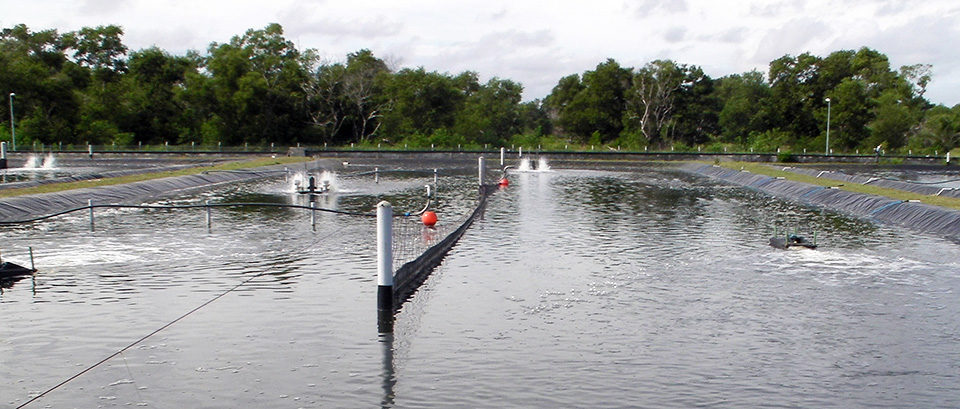
Biosecure facility design
The ARDC is a 5.15-ha production facility located on a 14-ha site in Sungai Paku in the Telisai district of Brunei. The production facility consists of 15, 2,500-m2 ponds with a 4:1 length:width ratio. These ponds can be configured differently to test various concepts for water circulation, sludge removal and aeration.
In addition, two, 7,000-m2 ponds are available to test whether design concepts can be scaled up without losing efficiency. The associated infrastructure includes offices, housing, labs, feed storage, an automated feeding system and a mechanical harvest system.
The production system is designed to maintain biosecurity with filtered and disinfected raw seawater, high-density polyethylene-lined ponds, bird netting and crab fencing. The volume of disinfected seawater is minimized by a centralized seawater recirculation system, which essentially eliminates the need for water exchange once ponds are filled. Operating procedures control sanitation and movement of vehicles, equipment and people within the facility.
Pond design
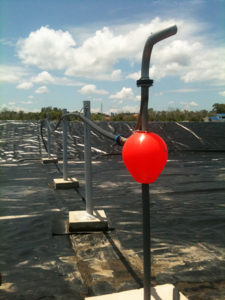
Conventional shrimp ponds tend to accumulate deposits of organic matter, which decompose anaerobically and release growth-retarding hydrogen sulfide. Aerators are often used to create horizontal water currents that deposit sludge near center drains, where it can be drained or siphoned from the pond. However, center drains lose efficiency as pond diameters increase.
At ARDC, three designs were tested to reduce the deposition of organic matter and improve energy efficiency: counter-rotating cells with paddlewheel aeration, counter-rotating cells with paddlewheel and submerged stratamix aeration, and a carousel system with paddlewheel and Venturi aeration.
To balance the self-cleaning benefits of small, round ponds and the lower construction costs of larger ponds, the counter-rotating cell with paddlewheel aeration incorporated four round circulation patterns in a side-by-side configuration. At the center of each cell was a sludge outlet controlled by a gate valve in the harvest drain. Sludge was drained frequently to prevent anaerobic activity and improve pond water quality.
The efficiency of diffused aeration increases with decreasing bubble sizes and increasing depth. In trials with Auburn University, a submerged “stratamix” system that diffused fine bubbles from a pipe 3 m below the pond bottom was found to be three times more energy efficient than conventional paddlewheels. The design incorporated a submerged stratamix system in each of the four counter-rotating cells of a pond.
The carousel design incorporated a central plastic curtain to partially divide the pond lengthwise, facilitating raceway-type water flow. While the self-cleaning efficiency of circular ponds declines with increasing pond diameter, raceways have the potential to be scalable without change in water circulation. To increase the self-cleaning aspect of this design, Venturi water jets were installed at intervals along the pond bottom.
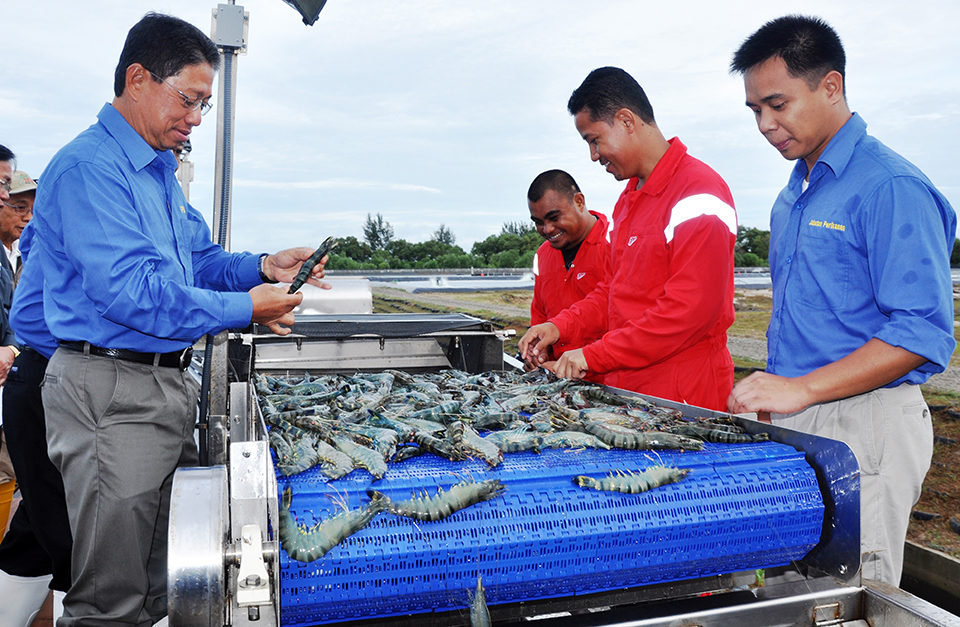
Wastewater treatment, reuse
Wastewater from all sludge drains and overflow pipes flowed to a common collection sump, where it was pumped into either of two parallel sets of three-stage treatment ponds. Each set was designed to receive wastewater flow for alternating 48-hour periods. The system can provide approximately 9 percent daily exchange when operating 15, 0.25-ha ponds or 6 percent exchange when operating 17 ponds.
Stage 1 ponds were 2.5 m deep and designed for settling solids, contact with activated sludge, anaerobic decomposition and denitrification. These ponds digested recalcitrant organic matter and released nitrogen in gaseous form. Black anoxic water from stage 1 ponds overflowed into stage 2 ponds that were vigorously aerated with paddlewheels and aspirating jet aerators.
These ponds detoxified metabolites from the anaerobic ponds and stimulated the growth of biofloc and algae. Oxidized water from stage 2 ponds overflowed to stage 3 ponds, which were not aerated and served to settle out excess solids before reuse.
The water treatment system was intermittently dosed with a probiotic and molasses on an as-needed basis according to visual observations of shrimp and water quality. Dolomite was applied to each pond weekly.
Automatic feeding
High-protein feed was measured and delivered to each pond by an automated feeding system that distributed four times daily at the beginning of the cycle and 12 times daily at the end of the cycle. Originally designed for salmon farms, the centralized feed system was pneumatically driven and computer-controlled. The software, which was adapted to work with shrimp ponds at the ARDC, automatically calculated, dosed and distributed feed to all ponds from a centrally located control center.
A 15-kw blower propelled feed through hoses to individual ponds at distances up to 500 meters. Feed quantities were controlled by dosing valves at the base of each of three silos. Feed from the dosing valves was directed to the appropriate hose for the particular pond by a selector device.
Rotary spreaders that passively swivel at the end of each hose provided circular feed distribution in response to the flow of air and feed. Each 0.25-ha pond was equipped with two rotors, and each 0.7-ha pond had four rotors.
Postlarval stocking
During a 30-day period beginning in September 2011, 15 ponds at ARDC were stocked with advanced postlarvae from specific pathogen-free black tiger shrimp produced at the Department of Fisheries breeding facilities. In this, the first production cycle at ARDC, minor debugging issues led to some ponds being stocked with insufficient preparation time and inadequate plankton blooms.
This led to stress and mortality in several ponds during the initial days after stocking. No other mortality issue was observed in this cycle.
Mechanical harvesting
A mechanical harvest system was used to reduce labor costs and maximize product quality. This system used a live-harvest pump to lift shrimp from the harvest gate of a draining pond to the harvest machine parked beside the pond.
The harvest machine separated shrimp from warm pond water, conveyed the dewatered shrimp to a chill tank, moved the chilled and dewatered shrimp to an inspection belt, and then conveyed them through a timed bath of sodium metabisulfite to prevent melanosis. The chilled and treated shrimp were then transported in iced boxes to the packing plant.
Production results
For the 2011 trials, the average culture period for the 15 ponds was 136 days, with average production of 1,573 kg/pond, average survival of 57 percent and average body weight of 48 grams (Figure 1, Table 1). The carousel ponds outperformed the counter-rotating and stratamix ponds in overall production. However, the stratamix ponds included three of the five ponds influenced by pond preparation problems and low survival. This comparison will be repeated.
Howell, ARDC production, Table 1
| Pond/System | A.M. Dissolved Oxygen Average | A.M. Dissolved Oxygen Minimum | A.M. Dissolved Oxygen Maximum | Survival Rate (%) | Harvest (g/m2) | Harvest (kg/hp/pond) | Harvest (kg/ha) | Feed-Conversion Ratio | Days | Daily Weight Gain (kg) |
|---|
Pond/System | A.M. Dissolved Oxygen Average | A.M. Dissolved Oxygen Minimum | A.M. Dissolved Oxygen Maximum | Survival Rate (%) | Harvest (g/m2) | Harvest (kg/hp/pond) | Harvest (kg/ha) | Feed-Conversion Ratio | Days | Daily Weight Gain (kg) |
|---|---|---|---|---|---|---|---|---|---|---|
| 3 | 5.28 | 3.39 | 7.22 | 76 | 750 | 1.78 | 159 | 11.79 | ||
| 4 | 5.59 | 3.81 | 7.26 | 67 | 640 | 1.38 | 141 | 11.30 | ||
| 5 | 5.52 | 3.90 | 7.16 | 45 | 340 | 1.22 | 122 | 6.98 | ||
| 6 | 5.40 | 3.10 | 7.15 | 69 | 950 | 1.82 | 149 | 15.89 | ||
| 7 | 5.34 | 2.11 | 7.01 | 55 | 700 | 1.60 | 137 | 12.85 | ||
| Counter-Rotating Average | 5.43 | 62 | 676 | 211.25 | 6,760 | 1.56 | 11.76 | |||
| 8 | 4.92 | 3.51 | 6.89 | 27 | 230 | 1.65 | 102 | 5.67 | ||
| 9 | 4.72 | 2.60 | 6.93 | 60 | 570 | 1.64 | 133 | 10.29 | ||
| 10 | 4.75 | 3.25 | 7.20 | 25 | 250 | 1.48 | 120 | 5.17 | ||
| 11 | 4.75 | 3.10 | 7.27 | 77 | 920 | 1.41 | 143 | 16.03 | ||
| 12 | 5.05 | 3.65 | 6.95 | 38 | 330 | 1.56 | 117 | 6.96 | ||
| 4.84 | 44 | 401 | 125.30 | 4,010 | 1.55 | 8.82 | ||||
| 13 | 4.44 | 2.32 | 7.52 | 70 | 740 | 1.42 | 141 | 13.19 | ||
| 14 | 4.29 | 1.97 | 7.38 | 39 | 420 | 2.32 | 140 | 6.88 | ||
| 15 | 4.30 | 2.20 | 7.61 | 69 | 740 | 1.61 | 139 | 13.22 | ||
| 16 | 4.21 | 2.10 | 6.48 | 72 | 1,060 | 1.42 | 145 | 18.22 | ||
| 17 | 4.55 | 2.52 | 7.53 | 66 | 800 | 1.47 | 146 | |||
| Carousel | 4.36 | 63 | 752 | 170.90 | 7,520 | 1.65 | 13.05 |
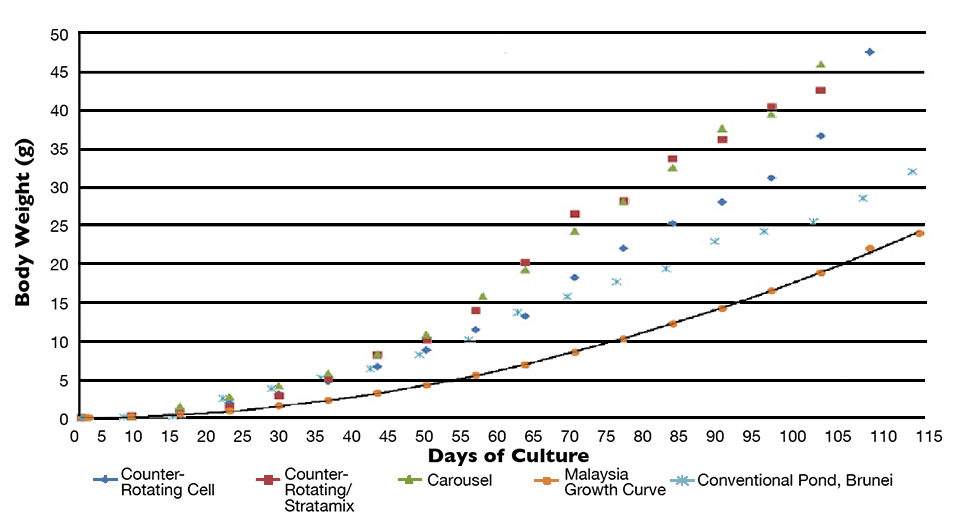
The counter-rotating system had the most efficient production with 211 kg/hp compared to 171 kg/hp in the carousel ponds. The carousel ponds exhibited lower dissolved-oxygen levels during the cycle in comparison to the other two systems. In addition, the temperature in the carousel ponds was slightly higher when compared to the counter-rotating and stratamix aeration systems.
Perspectives
The studies demonstrated that black tiger shrimp can be intensively grown to large sizes with fast growth and high feed efficiency in biosecure, environmentally friendly ponds. Average production exceeded 6,000 kg/ha with a range of 4,000 to 7,500 kg/ha. The best pond produced over 10,000 kg/ha. The average feed-conversion ratio was 1.59:1 with a range of 1.22:1 to 2.32:1. Average growth was 2.55 g/week with a range of 1.81 to 3.10 g/week.
Variations observed in the first production cycle indicated opportunities for further optimization of pond preparation, stocking density and pond management to further improve production, feed conversion and growth rates.
(Editor’s Note: This article was originally published in the January/February 2013 print edition of the Global Aquaculture Advocate.)
Now that you've reached the end of the article ...
… please consider supporting GSA’s mission to advance responsible seafood practices through education, advocacy and third-party assurances. The Advocate aims to document the evolution of responsible seafood practices and share the expansive knowledge of our vast network of contributors.
By becoming a Global Seafood Alliance member, you’re ensuring that all of the pre-competitive work we do through member benefits, resources and events can continue. Individual membership costs just $50 a year.
Not a GSA member? Join us.
Authors
-
Chris Howell
Integrated Aquaculture International
3303 West Twelfth Street
Hastings, Nebraska 68902-0609 USA -
Tom James
Department of Fisheries
Brunei Darussalam -
Rosinah Yussof
Department of Fisheries
Brunei Darussalam -
Abidah Yazid
Department of Fisheries
Brunei Darussalam -
Syairazi Suni
Department of Fisheries
Brunei Darussalam
Tagged With
Related Posts
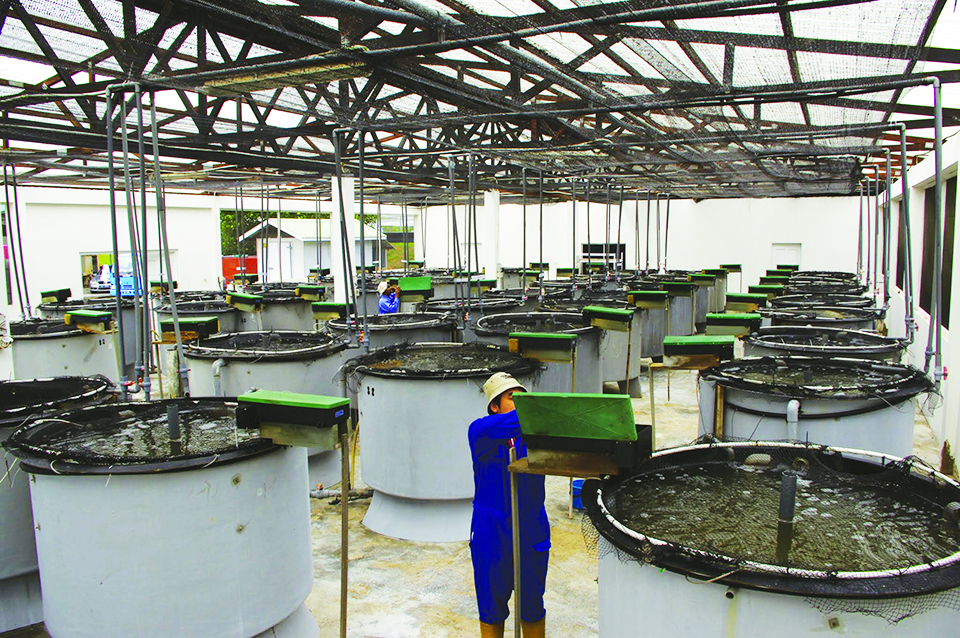
Health & Welfare
Brunei project develops technology for large black tiger shrimp production, part 4
Nutrition research run in conjunction with the breeding program ensures that cost-effective feeds are optimized for shrimp performance for a five-year project undertaken in Brunei Darussalam to develop advanced technology for production of large black tiger shrimp.
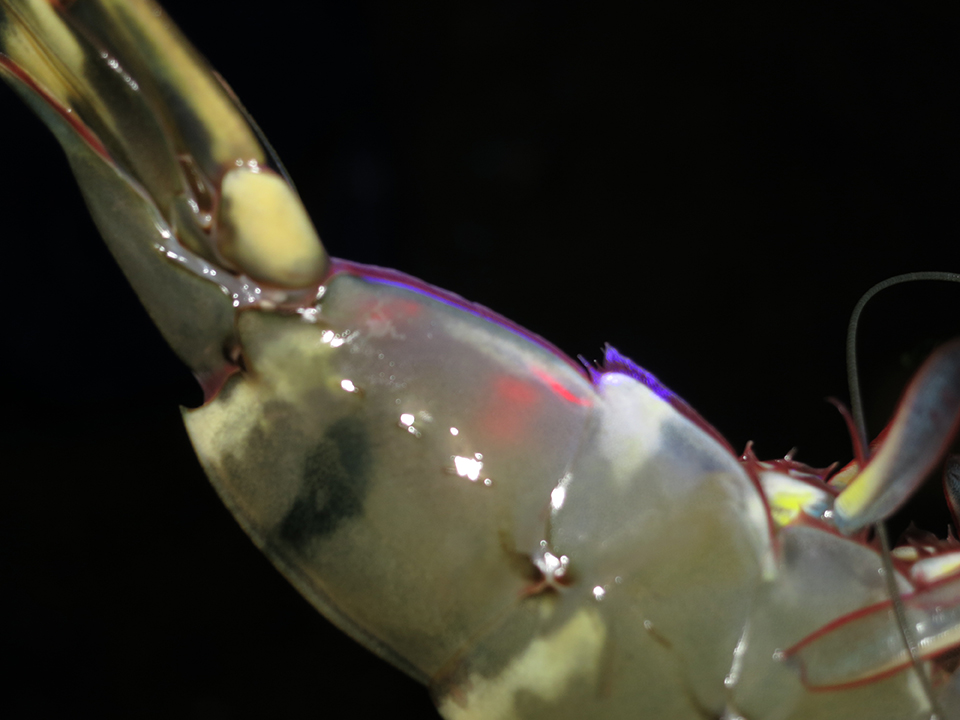
Health & Welfare
Brunei project develops technology for large black tiger shrimp production, part 3
Specific pathogen-free offspring developed from founder populations of P. monodon collected from Brunei coastal waters were introduced into a biosecure breeding program, where they have been reared to the fifth generation using family-based selection for reproduction and growth.
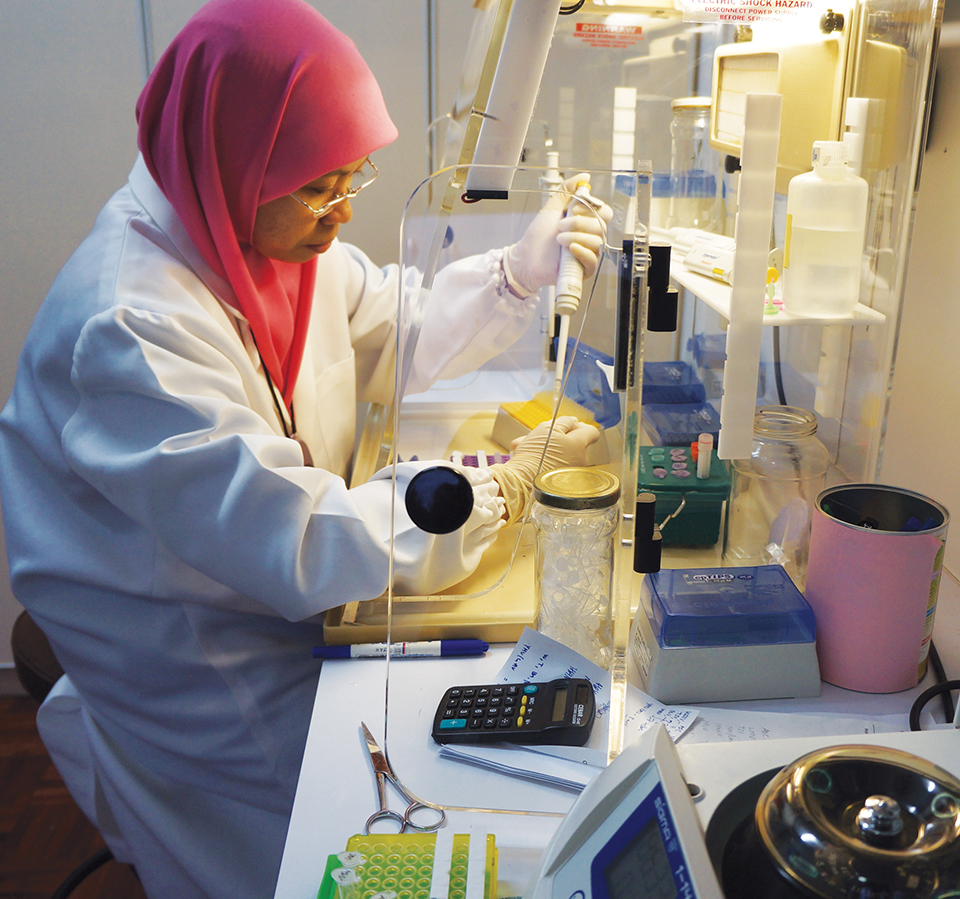
Health & Welfare
Brunei project develops technology for large black tiger shrimp production, part 2
For a five-year project undertaken in Brunei Darussalam to develop advanced technology for production of large black tiger shrimp, a comprehensive disease diagnostic laboratory was developed to enable detection of known and emerging shrimp pathogens by molecular and histological methods.
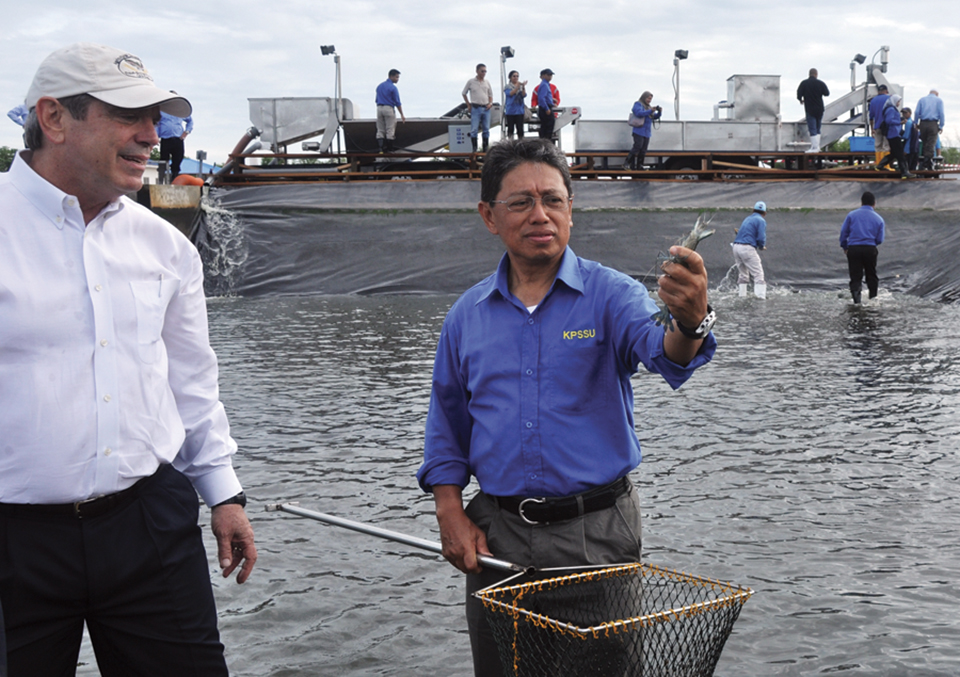
Health & Welfare
Brunei project develops technology for large black tiger shrimp production, part 1
A five-year project was undertaken in Brunei Darussalam to develop advanced technology for the production of large black tiger shrimp. A combination of technologies has enabled efficient production of large-sized black tiger shrimp, which could lead to a resurgence of this species in Asia.



